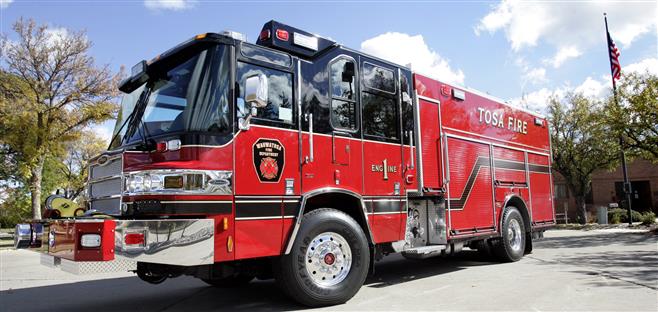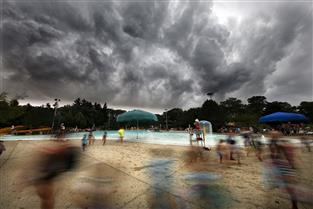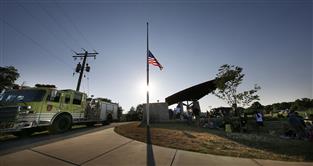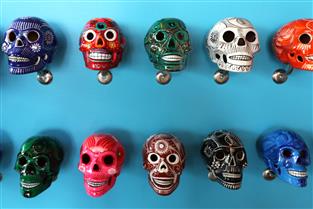Wauwatosa Fire Department puts new engine on the road, under budget
Cost in $50,000 under budget

Wauwatosa's newest fire engine went into service on Oct. 11 and features a return to the traditional red color scheme with improved emergency lighting and a shorter turning radius. The engine will be a first response vehicle based at Station 1 in the Village and replaces a 1991 engine. Photo By C.T. Kruger
In its first day of service last week, the Wauwatosa Fire Department's new engine had responded to two calls by 1 p.m.
If the year ahead is like years past, the truck will respond to a healthy proportion of the 5,500 calls the department will field this year, including a couple of dozen serious "working fires," and 30 to 40 mutual aid calls, to help out other departments.
The truck, a Pierce Quantum model with a 450-horsepower engine, carries 500 gallons of water, 30 gallons of foam, medical aid equipment and supplies, air tanks for firefighters that are refillable at the truck from large supply tanks, 800 feet of hose to connect the truck to a hydrant, and 1,500 feet of attack hose. And it does 65 miles an hour.
"People think, 'Oh it's a fire truck, so it goes to fires.' We go to fires, car accidents, ambulance calls - I mean it's got to do it all. It's got water rescue (survival suits and life rings)… it's very diverse in its needs that way," said Assistant Fire Chief Scott Erke.
New model is more compact
And yet, at about 32 feet long, less than 11 feet high, and generally staffed by only three firefighters, it's surprisingly compact.
"The wheelbase is actually one of the shorter wheelbase rigs that we have in the city now, so it's got the ability to get through traffic quickly and get where we need to go," said Battalion Chief Robert Shepherd.
The truck has a pump under the cab, Shepherd said, which allows it to be shorter than trucks of an older design that placed the pump behind the cab.
The engine, a return to traditional black on red from the lemon-lime color of recent purchases, cost $599,000, less than the $650,000 set aside for it in the 2012 city budget. In searching for an engine it liked, the department found one in O'Fallon, Mo., and ordered the same model, with a few custom tweaks, from Pierce Manufacturing of Appleton, the largest manufacturer of fire apparatus in North America, Shepherd said.
The department received the truck on Sept. 27 and spent two weeks training drivers and firefighters in the use of it, using parking lots and city streets - like a young driver with a permit - and training on the hoses and other equipment.
Shepherd and Erke said the engine replaces a 16-year-old "quint," a truck that combined the purposes of a ladder truck and an engine that will spend a couple of years on reserve status before it is sold. An older quint, already on reserve, will be sold to make room for the change.
By purchasing the Quantum, the department is getting a more compact, more maneuverable and likely more durable vehicle that is still full-service, Erke said. Dedicated ladder trucks would respond in the cases where that was required.
Older trucks vulnerable
The quint concept was popular a few years ago because of its multipurpose design, but the length (45 feet), lack of maneuverability, and stresses put on such a heavily equipped and heavily used vehicle made it vulnerable to breakdown.
Erke said the department spent $30,000 in repairs last year on the truck that is being replaced, and displayed a huge fender that had rattled right off.
"The quints, they do a lot of things, but they don't do anything well," Shepherd said.
The new vehicle has a roomier cab and independent front and rear suspension, which makes the ride easier and is easier on the equipment than the rear-only mechanical suspension system of the older truck.
Buying a new truck means getting rid of an old one. The one on the way out is a 1991 model, "very well used," Erke said, that was bought new for $125,000 to $150,000. Erke said church and charitable organizations buy the old trucks and donate them to Central and South American countries, where they're put back into service.
"We'll be lucky to get $5,000 for it," Shepherd said.
More from News and Features
- Anodyne Coffee plans to open location in Wauwatosa Village
- Wauwatosa Meetings: Aug. 4
- Video: Wauwatosa girl's curbside ice cream stand raises money for the hungry
- Wauwatosa News and Notes: Hands-only CPR training offered; Firefly Art Fair is Aug. 6-7
- Wauwatosa Ask Now: Why are there barriers and fencing along the North Avenue bridges over the Menomonee River?
- Mystery Photo Contest: July 28
- Wauwatosa gears up for National Night Out event, this year at the zoo
- Election 2016: Wisconsin's 4th District candidates weigh in
- Wauwatosa's Luther Manor residents share smiles through flower delivery
- Wauwatosa Police Report: July 17-23














